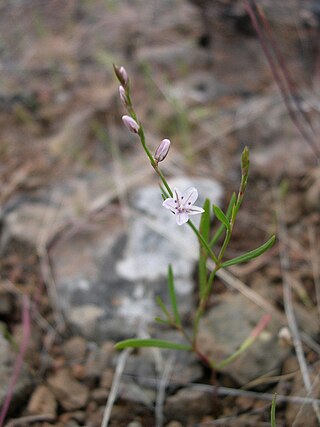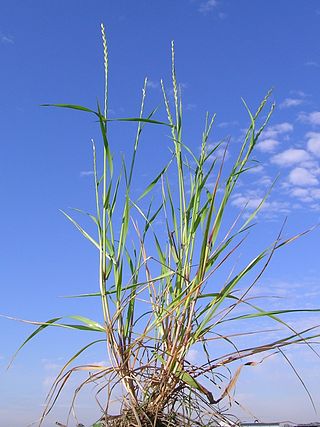
Weed control is a type of pest control, which attempts to stop or reduce growth of weeds, especially noxious weeds, with the aim of reducing their competition with desired flora and fauna including domesticated plants and livestock, and in natural settings preventing non native species competing with native species.

Allium vineale is a perennial, bulb-forming species of wild onion, native to Europe, northwestern Africa and the Middle East. The species was introduced in Australia and North America, where it has become an Invasive species.

Rumex obtusifolius, commonly known as bitter dock, broad-leaved dock, bluntleaf dock, dock leaf, dockens or butter dock, is a perennial plant in the family Polygonaceae. It is native to Europe, but is found on all temperate continents. It is a highly invasive species in some zones, resulting from its abundant seed dispersal, adaptability to reproduce, aggressive roots, ability to tolerate extreme climates, and hardiness.

Polygonum arenastrum, commonly known as equal-leaved knotgrass, is a summer annual flowering plant in the knotweed family Polygonaceae. Other common names include common knotweed, prostrate knotweed, mat grass, oval-leaf knotweed, stone grass, wiregrass, and door weed, as well as many others. It is native to Europe and can be found on other continents as an introduced species and a common noxious weed. Knotweed was first seen in North America in 1809 and is now seen across much of the United States and Canada.

Veronica chamaedrys, the germander speedwell, bird's-eye speedwell, or cat's eyes, is a herbaceous perennial species of flowering plant in the plantain family Plantaginaceae.

Veronica is the largest genus in the flowering plant family Plantaginaceae, with about 500 species. It was formerly classified in the family Scrophulariaceae. Common names include speedwell, bird's eye, and gypsyweed.

Veronica persica is a flowering plant in the family Plantaginaceae. Common names include birdeye speedwell, common field-speedwell, Persian speedwell, large field speedwell, bird's-eye, or winter speedwell. It is native to Eurasia and is widespread as an introduced species in the British Isles, North America, eastern Asia, including Japan and China, and Australia and New Zealand.

Alopecurus myosuroides is an annual grass, native to Eurasia, found in moist meadows, deciduous forests, and on cultivated and waste land. It is also known as slender meadow foxtail, black-grass, twitch grass, and black twitch.

Veronica arvensis, common names: wall speedwell, corn speedwell, common speedwell, rock speedwell, field speedwell, is an annual flowering plant in the plantain family Plantaginaceae. The species is native to Europe and a common weed in gardens, pastures, waste places, and cultivated land.

Veronica hederifolia, the ivy-leaved speedwell, is a flowering plant belonging to the family Plantaginaceae. It is native to Europe, western Asia and north Africa and it is present in other places as an introduced species and a common weed. Solitary blue flowers occur in leaf axils, each with a corolla up to one centimetre (0.4 in) wide. The fruit is a dehiscent capsule.

Bromus hordeaceus, the soft brome, is an annual or biennial species of grass in the grass family (Poaceae). It is also known in North America as bull grass, soft cheat, and soft chess.

A weed is a plant considered undesirable in a particular situation, growing where it conflicts with human preferences, needs, or goals. Plants with characteristics that make them hazardous, aesthetically unappealing, difficult to control in managed environments, or otherwise unwanted in farm land, orchards, gardens, lawns, parks, recreational spaces, residential and industrial areas, may all be considered weeds. The concept of weeds is particularly significant in agriculture, where the presence of weeds in fields used to grow crops may cause major losses in yields. Invasive species, plants introduced to an environment where their presence negatively impacts the overall functioning and biodiversity of the ecosystem, may also sometimes be considered weeds.

Veronica filiformis is a species of flowering plant in the family Plantaginaceae. It is known by many common names, including slender speedwell, creeping speedwell, threadstalk speedwell and Whetzel weed. It is native to eastern Europe and western Asia, and it is known in many other regions as an introduced species.
Thyme is any member of the genus Thymus of aromatic herbs with culinary, medicinal, and ornamental uses.

Crepis tectorum, commonly referred to as the narrowleaf hawksbeard or narrow-leaved hawk's-beard, is an annual or winter annual plant between 30 and 100 centimetres in height. Originating in Siberia before being introduced to Canada in 1890, the narrowleaf hawksbeard's is an invasive species. Maintaining one branched, hairless and leafy stem during maturity, the narrowleaf hawksbeard has yellow leaves which are arranged in an alternate manner and less than 0.5 inches (13 mm) wide.

Croton glandulosus is a species of plant in the family Euphorbiaceae that has many common names such as vente conmigo, tooth-leaved croton, tropic croton and sand croton. The species's specific epithet, glandulosus, is due to the gland-like structures that appear at the end of the leaf stalk. C. glandulosus and various other species are found to be common weeds in gardens, crops, and lawns. This species in particular is highly problematic in crops such as cotton and peanuts in the Southeastern United States.

Polygonum majus is a North American species of flowering plant in the buckwheat family known by the common name wiry knotweed. It grows in the western United States and western Canada, from British Columbia south as far as the Sierra Nevada of northwestern Inyo County in California, east as far as Montana. Knotweed is a spreading, wiry annual weed that rarely grows higher than a few inches. The leaves are tiny, oblong, bluish-green, and 14 inches broad and 1 inch long. The flowers are tiny and unobtrusive, whitish-green in colour, and appear in the leaf axils in the fall. Knotweed may grow into a dense mat with a diameter of up to three feet, strangling out ideal grass and plants. The branches of this evergreen plant form a strong, wiry mat that reaches barely a few centimeters above the earth. They appear constantly, and gardeners are always fighting them.

Lolium rigidum is a species of annual grass. Common names by which it is known include annual ryegrass, a name also given to Italian ryegrass, rigid ryegrass, stiff darnel, Swiss ryegrass and Wimmera ryegrass. It is a native of southern Europe, northern Africa, the Middle East and the Indian subcontinent and is grown as a forage crop, particularly in Australia, where it is also a serious and economically damaging crop weed.
Broadleaf weeds are unwanted tough plants that may grow in lawns, gardens or yards. They can be easy to spot when growing among grasses. They multiply with ease and can be very hard to eradicate.

Veronica catenata, the pink water speedwell, is a species of flowering plant in the family Plantaginaceae. It is native to Canada, the United States, Europe, the Azores, and northern Africa. As its common name implies, it prefers growing in or near marshes, rivers, lakes and ponds.




















